The term “soulmate” refers to an individual ideally suited to another as a close friend or romantic partner, embodying a deep, intrinsic connection that transcends superficial attributes. Popularized in modern culture through various media, such as the 1996 drama “Jerry Maguire,” where the phrase “You complete me” became emblematic of soulmate love, the concept carries significant cultural and historical weight.
Etymologically, “soulmate” can be linked to the Greek root words [andros] (masculine) and [gyne] (feminine), combining to form “androgyny”—the blend of male and female characteristics within one individual.
Merriam-Webster extends the definition beyond romantic contexts, suggesting that a soulmate can be a typical companion or something very similar to another, encompassing a range of intimate connections.
Historically, the concept of soulmates has deep roots across various cultures and eras. In ancient Greek philosophy, the soul’s journey and quest for unity were early frameworks for the soulmate idea, as explored in works by philosophers like Plotinus and the Neoplatonists.
Hindu mythology narrates the origin of love through the story of Purusha, divided by Brahma to symbolize the human quest for completeness.
The Middle Ages and the Renaissance periods further developed these ideas through humanism and the rediscovery of ancient texts, influencing contemporary thought on love and the soul.
Indigenous cultures have long embraced spiritual practices and rituals that emphasize unity and love, reinforcing the timeless human yearning for deep connections.
Cultural perspectives on soulmates vary widely. Indigenous cultures in North America and American Indian communities have diverse traditions emphasizing spiritual connections and kinship, often disrupted by European colonization but undergoing revitalization efforts today.
East Asian perspectives highlight how historical, geographical, and social factors shape cognitive styles and relational behaviors, offering a contrast to Western individualistic approaches.

These cultural differences underscore the profound impact of history, geography, and social environments on our understanding of soulmates. Psychologically, the idea of soulmates intersects with attachment theory and concepts of psychological development. Attachment styles, such as anxious-preoccupied and avoidant, significantly influence adult romantic relationships, shaping how individuals seek intimacy and handle emotional expressiveness.
Modern developments in attachment theory, like the concept of mentalization, offer new insights into understanding and fostering healthier relationships.
Equanimity and therapeutic approaches aim to address past wounds and promote emotional regulation, essential for nurturing deep, balanced connections. In summary, the concept of a soulmate is deeply embedded in human history, culture, and psychology. While it evokes a profound yearning for connection and unity, it also faces criticism for fostering unrealistic expectations and cultural biases. By exploring diverse perspectives and psychological frameworks, the understanding of soulmates continues to evolve, reflecting the complexity and richness of human relationships.
Dive into the captivating history and modern understanding of soulmates with the mystical insights of Psychic Luna. Renowned for her unique talent in creating personalized soulmate sketches, Luna connects deeply with spiritual energies to reveal your perfect match. As you explore how soulmates have shaped love across cultures and eras, let Luna bring your soulmate to life with a detailed, intuitive sketch that captures their essence.
Definition

The term “soulmate” is commonly understood as a person ideally suited to another as a close friend or romantic partner. The concept often implies a deep, intrinsic connection that transcends superficial attributes. This idea has been popularized in modern culture through various media, including the 1996 drama “Jerry Maguire,” where the phrase “You complete me” became emblematic of soulmate love. In etymological terms, “soulmate” can be likened to the Greek root words [andros] (masculine) and [gyne] (feminine), which combine to form “androgyny”—the blend of both male and female characteristics within one individual. Additionally, Merriam-Webster provides a broader definition, likening a soulmate to something very similar to or a typical companion to another, thereby not restricting the term solely to romantic contexts. This extended definition includes examples such as “Discovery, like its soul mate love, is a many-splendored thing”. Thus, the term “soulmate” encompasses a range of intimate connections, whether they be romantic, platonic, or otherwise spiritually significant.
Historical Context
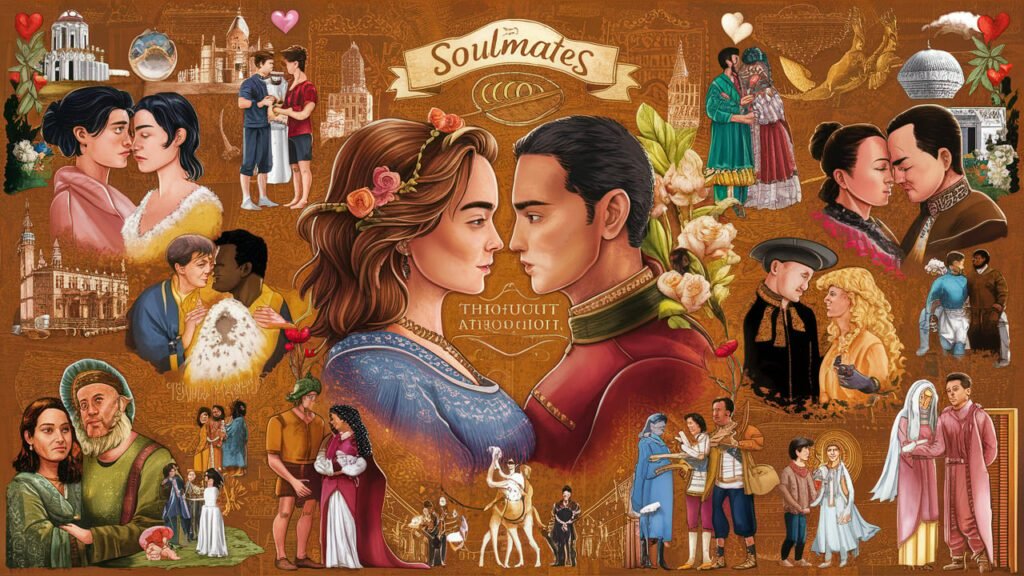
The concept of a soulmate has deep historical roots and can be traced back through various cultures and eras.
Ancient Greece
In ancient Greek philosophy, the notion of the soul, or “psūkhē,” was central to understanding the concept of a soulmate. Greek literary, ritual, and philosophical traditions explored the multifaceted nature of the soul, beginning with foundational works such as those by Homer and Hesiod and progressing through the profound theories of later philosophers like Plotinus and the Neoplatonists. These traditions often considered the soul’s journey and its quest for unity and completeness, which can be seen as an early framework for the idea of a soulmate.
Hinduism
Hinduism offers a narrative about the origin of love that bears resemblance to the soulmate concept. According to Hindu mythology, a powerful being named Purusha was initially whole and lacked desires or fears because the universe was perfect. Brahma, the creator, used his divine sword to divide Purusha into two, symbolizing the inception of the quest for unity among humans. Love is described as the word we use for this search for completeness.
Middle Ages and the Renaissance
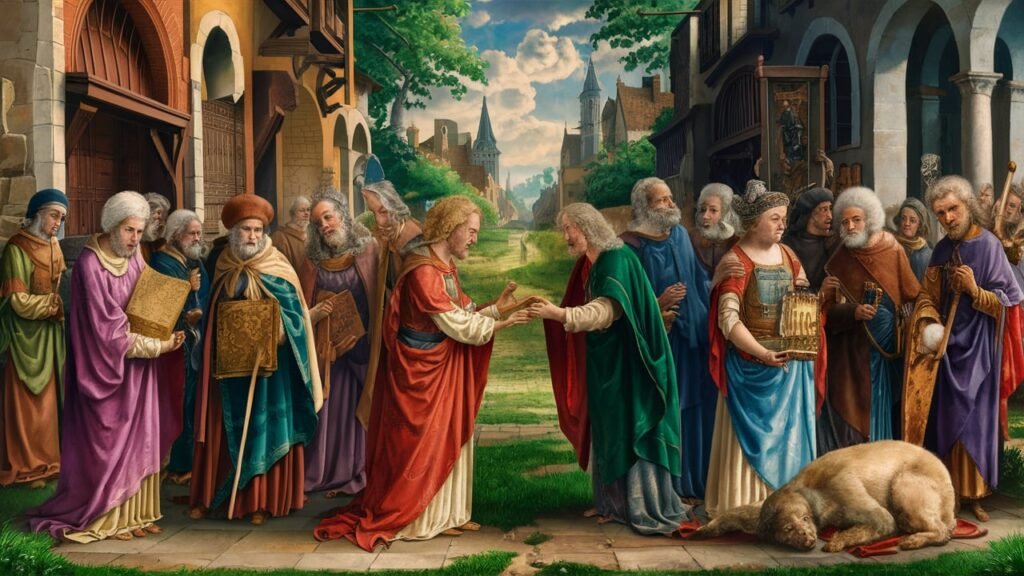
The period known as the Middle Ages, spanning roughly from the 5th to the 15th century, was characterized by significant social, political, and intellectual transformations. This era set the stage for the Renaissance, a time marked by a revival of Classical learning and values. The Renaissance brought about a renewed interest in humanism, the exploration of new continents, and substantial advancements in various fields including art, science, and commerce. This cultural rebirth, which included the rediscovery of ancient texts and the influence of Classical scholarship, provided a fertile ground for the evolution of ideas about love and the soul.
Indigenous Cultures
Indigenous cultures have long-held traditions of storytelling, dances, performances, songs, and art to pass down knowledge, including spiritual and cultural practices related to the concept of unity and love. These traditions emphasize a connection to nature, the earth, and one another, reinforcing the idea that spiritual practices and rituals can nurture relationships and a sense of completeness.
Modern Context
Despite the pervasive effects of modern society, there are instances of remarkable continuity with past traditions, as well as creative adaptations to the present. The erosion of traditional languages and rituals has not obliterated the deep-seated human yearning for connection and unity, reflective of the soulmate concept. Communities continue to find ways to preserve their spiritual vocabularies and rituals, maintaining a link to their historical roots while navigating the complexities of contemporary life.
Cultural Perspectives
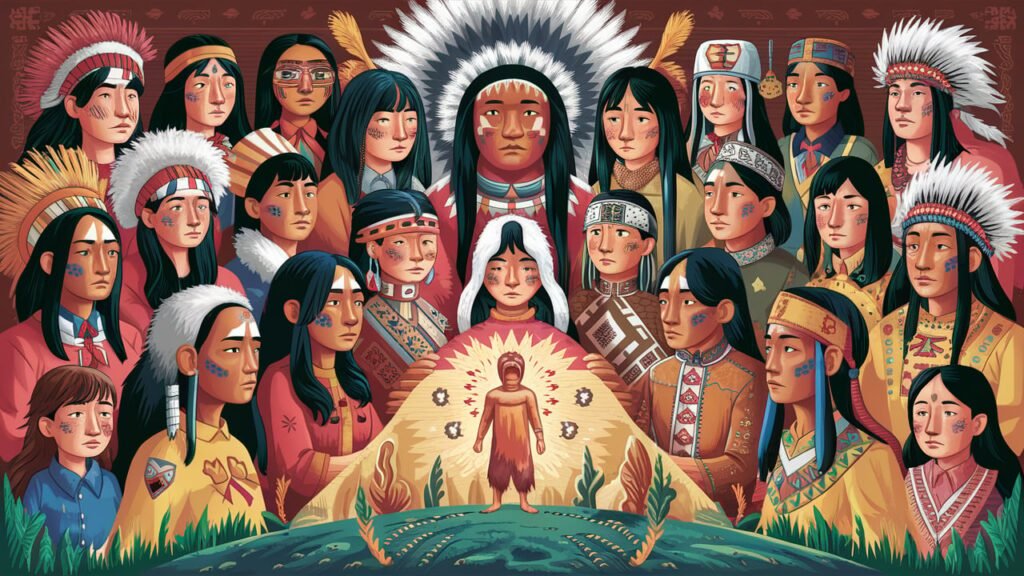
Indigenous Cultures in North America
Indigenous peoples have inhabited North America, including Canada, for tens of thousands of years, long before colonization. In Canada, the Indian Act (1985) and the Constitution of Canada (1982) recognize three main Indigenous groups: First Nations, Inuit, and Métis. These groups are composed of more than 50 distinct Indigenous nations, over 630 groups or bands, and speak over 60 languages. Indigenous cultures are incredibly diverse, with unique beliefs, values, and practices that have evolved over thousands of years. Traditional knowledge and cultural practices are primarily passed down orally through storytelling, dances, performances, songs, and art. Despite their diversity, Indigenous peoples share a common spirituality rooted in their connection to nature and the earth, and they recognize death as part of the circle of life.
American Indian Cultures
American Indian cultures are equally diverse, comprising over 2,000 tribal groups with unique languages, social practices, arts, music, ceremonies, and customs. Historically, well-established conventions and practices, such as rites of passage and social and gender roles, nurtured individual identity within these communities. However, contact with Europeans and Americans disrupted traditional norms. Today, Native identity is influenced by complex social, political, historical, and cultural factors. In recent decades, many American Indian communities have sought to revitalize and reclaim their languages and cultures. Kinship and extended family relationships have always been, and continue to be, essential in shaping American Indian cultures, which remain dynamic and ever-changing.
East Asian Perspectives
Cultural perspectives on identity and behavior also differ significantly between East and West. For instance, a study by Richard Nisbett at the University of Michigan found that East Asian participants tend to focus more on the background context of an image, while Americans concentrate more on the main subject. This distinction suggests that cultural environments can shape cognitive styles from a young age . Additionally, historical and geographical factors, such as the types of crops farmed by ancestors, can influence cognitive development.
The Role of Geography in Cultural Development
Geography plays a crucial role in shaping cultural identities and cognitive styles. For example, Thomas Talhelm’s research on different provinces in China found that local agricultural practices could influence social behaviors and thought patterns. Similarly, the historical expansion into the American ‘Wild West’ fostered a more individualistic mindset among pioneers, a phenomenon also observed in Japan’s northern territory of Hokkaido. Despite Japan’s generally collectivist culture, the migration to Hokkaido cultivated a more independent outlook among its settlers, paralleling the American frontier experience. By examining these diverse cultural perspectives, it becomes evident that history, geography, and social environments profoundly shape our identities, behaviors, and cognitive styles.
Psychological Perspectives

Understanding True Love and Psychological Development
True love involves genuine deep caring, good communication, and empathic experiential or emotional intimacy in interpersonal relationships. Psychological factors play a crucial role in either facilitating or impeding the development of such relationships. This includes therapeutic healing, resolving emotional pain, and the development of a psychologically healthy and mature strength of character, often referred to as “ego strength”.
Attachment Theory
Attachment theory, developed by John Bowlby, provides a framework for understanding how early relationships with caregivers influence an individual’s emotional and social development. The theory posits that young children need to form a bond with at least one primary caregiver for their survival and healthy development. Attachment theory has evolved to include several attachment styles, including anxious-preoccupied, avoidant, and secure attachments, each influencing adult romantic relationships differently.
Anxious-Preoccupied Attachment
Anxious-preoccupied individuals seek high levels of intimacy and approval from partners, often becoming overly dependent. They tend to be less trusting and may exhibit high levels of emotional expressiveness and worry in relationships. This attachment style stems from inconsistent caregiving, leading to heightened anxiety and uncertainty in relationships.
Avoidant Attachment
Avoidant individuals tend to maintain emotional distance in relationships. They often view themselves as self-sufficient and may struggle with intimacy and expressing emotions. This behavior is typically a result of caregivers who were unresponsive or distant during the individual’s formative years.
Therapeutic Implications
Therapeutic approaches often focus on building a secure therapeutic relationship and addressing fears of abandonment and rejection. Understanding transference is crucial, as clients may project their anxieties onto the therapist. Therapy aims to develop a more secure attachment style, promoting emotional regulation and healthier relationship patterns.
Modern Developments in Attachment Theory
Psychoanalysts Peter Fonagy and Mary Target have attempted to integrate attachment theory with cognitive science through the concept of mentalization. Mentalization involves the ability to understand the mental states of oneself and others, facilitating better emotional and social functioning. This connection opens new areas of study, potentially leading to alterations in traditional attachment theory.
Equanimity in Relationships
The theory of Equanimity teaches individuals to observe their emotions and reactions without immediate response. This mental state is particularly valuable in relationships that trigger past wounds, allowing individuals to understand and learn from unhealthy behavioral patterns. By mastering their thoughts and expressions, individuals can foster healthier and more balanced relationships.
Religious and Spiritual Perspectives
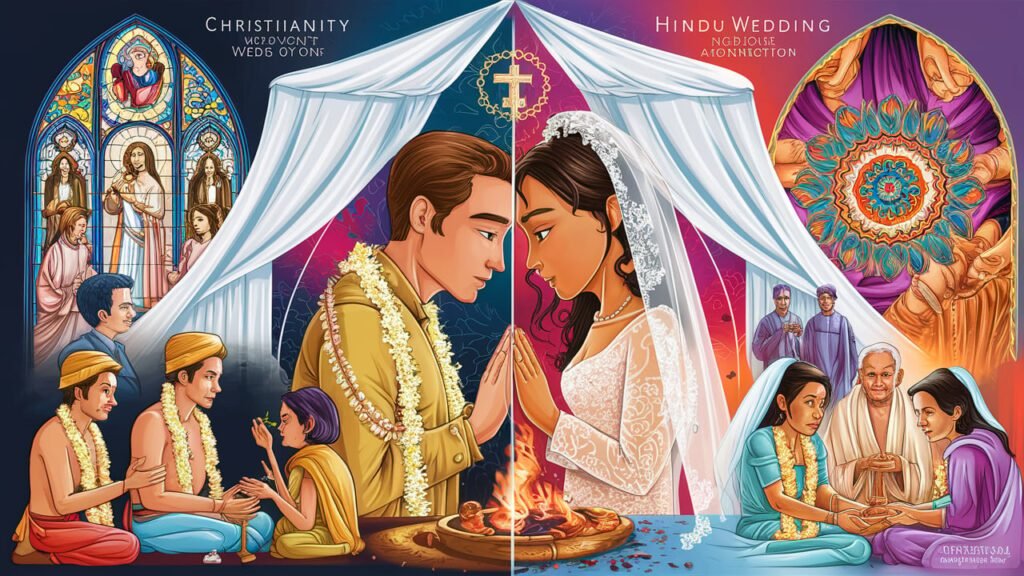
Christianity
Biblical Views on Marriage and Soulmates
Christianity presents a well-defined perspective on marriage, often tied to spiritual principles rather than the modern concept of soulmates. Biblical texts emphasize the sanctity and permanence of marriage, portraying it as a divine institution established by God. In Matthew 19:4-6, Jesus highlights the enduring nature of marriage, indicating that it reflects God’s design and should not be dissolved lightly According to Christian doctrine, marriage is intended to mirror the relationship between Christ and the Church. This notion is reinforced in Ephesians 5:25-27, where the sacrificial love of Christ for the Church is likened to the love husbands should have for their wives. The Bible encourages believers to pursue relationships that are “equally yoked” (2 Corinthians 6:14), meaning partnerships should be founded on shared faith and values, rather than seeking a predestined ‘soulmate’.
Hinduism
Hinduism offers a rich tapestry of beliefs regarding love and soul connections. According to Hindu mythology, the origin of love is depicted through the story of Purusha, who was divided by Brahma to create humans. This division signifies the inherent human quest for unity, which is expressed through love. The religion also emphasizes karma and reincarnation, where the actions of past lives influence one’s current and future existence. The ultimate goal in Hinduism is to achieve moksha, a state of enlightenment and liberation from the cycle of rebirth. Additionally, Hindu culture holds that individuals have karmic connections with certain souls, influencing their relationships across lifetimes. This belief in karmic ties extends to popular culture, as seen in the film “Eternal Sunshine of the Spotless Mind,” which explores the idea of soulmates reuniting despite erased memories.
Buddhism
Buddhism, much like Hinduism, encompasses a view of interconnectedness and karmic ties that influence human relationships. While it does not specifically focus on the concept of soulmates, Buddhism underscores the ethical and egalitarian nature of human connections, as taught by Buddha. The Vedic texts, which are foundational to Indian religious tradition, also delve into philosophical discussions about the soul and its journey towards enlightenment.
Native American Perspectives
Native American spirituality emphasizes a deep connection to nature and the teachings that govern harmonious living. Central to these teachings are the seven sacred values: respect, love, humility, honesty, wisdom, courage, and truth. These teachings not only foster personal growth and a deeper understanding of the world but also advocate for the well-being of communities and the preservation of nature. The belief is that by embracing these teachings, individuals can create a more peaceful world that honors both human connections and the connection to Mother Earth.
Literary and Media Representations
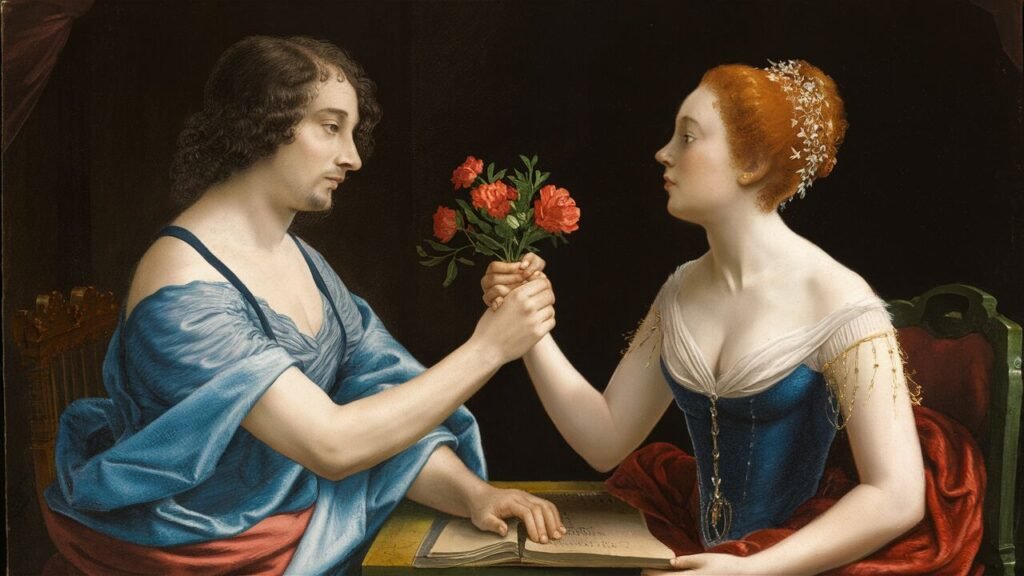
The concept of a soulmate has permeated literature and media for centuries, finding its way into a myriad of narratives across cultures and eras.
Renaissance Literature
In Renaissance literature, the notion of soulmates often intertwines with the era’s humanist and philosophical ideals. Works by poets like Joachim Du Bellay and Sir Philip Sidney reflect this through their discussions on love and human connection. Du Bellay’s La Défense et illustration de la langue française and Sidney’s Defence of Poetry provide insights into the literary programs of the Pléiade and Elizabethan poetry respectively, albeit in a more polemical and manifesto-like style. This period also saw the harmonizing of classical texts like Horace’s Ars Poética and Aristotle’s Poetics, which influenced contemporary literary criticism and, by extension, representations of idealized relationships.
Romantic Period
During the Romantic period, the soulmate concept evolved further. Percy Bysshe Shelley, a prominent figure among the English Romantics, drew heavily on Platonic traditions and created visionary works that often explored the theme of ideal love. His unfinished masterpiece, The Triumph of Life, and other works like Epipsychidion, highlight his quest for transcendent and perfect connections. Similarly, German Romantics like Novalis and Friedrich Hölderlin infused their poetry with mythic and naturalistic elements that resonated with the idea of soulmates as predestined, harmonious unions. French Romanticism, embodied by Victor Hugo, also delved into allegorical narratives that portrayed soulmates within a cosmology of pantheist and occult forces.
Modern and Contemporary Media
The portrayal of soulmates has continued into modern and contemporary media, often in more explicit and diverse forms. This concept is frequently explored in novels, films, and even operatic librettos, reflecting ongoing cultural fascinations with the idea of predestined partners. For instance, W.H. Auden’s operatic works leverage allegorical potential to explore deep thematic concerns, including those related to soulmate connections. Moreover, the adaptation of classical texts into films, such as the works of Shakespeare and other Renaissance authors, keeps the exploration of these idealized relationships alive in modern contexts. The portrayal of soulmates in these varied media continues to evoke the timeless human desire for profound and lasting connections.
Criticism and Controversy

The concept of soulmates has often been met with criticism and controversy, both from psychological and literary perspectives.
Psychological Criticism
From a psychological standpoint, the idea of soulmates is often criticized for fostering unrealistic expectations in relationships. Anxious-preoccupied adults, for instance, seek high levels of intimacy and approval from their partners, becoming overly dependent. They tend to have less positive views about themselves and may exhibit high levels of emotional expressiveness and impulsiveness in their relationships. This anxiety can prevent the establishment of satisfactory defense mechanisms against separation anxiety, leading to an overreaction to the anticipation or actual separation from their attachment figure. This dependency on the notion of a perfect partner or soulmate can hinder individuals from developing a healthy and balanced approach to relationships. Psychoanalysts and psychologists, such as Peter Fonagy and Mary Target, have tried to bridge attachment theory and psychoanalysis, proposing that understanding mentalization, or theory of mind, can offer new insights into attachment theory. This connection may lead to significant alterations in how relationships and the concept of soulmates are perceived and studied.
Literary and Historical Criticism
In literary and historical contexts, the concept of soulmates is often entangled with other intellectual and cultural agendas. Renaissance literary critics, for example, explored various forms of relationships and their complexities. Their works were part of the broader history of literary criticism, which began to take a more formal shape in sixteenth-century Italy. These critics developed a tradition of commentary and debate on literary theory that indirectly touched upon ideas of perfect companionship and intellectual affinity. Notable literary works from the Renaissance period, such as Erasmus’s “The Praise of Folly” and Machiavelli’s “The Prince,” though not directly addressing soulmates, explored themes of human folly and political manipulation that indirectly questioned the idealism often associated with perfect relationships. Erasmus’s use of the word “folly” in different ways has kept critics busy for centuries, trying to understand his true intentions, suggesting that the pursuit of ideal relationships may be as flawed and complex as the human condition itself.
Sociocultural Criticism
Sociocultural perspectives also criticize the soulmate concept by highlighting its potential biases and the influence of societal norms. For instance, the “WEIRD” (Western, Educated, Industrialized, Rich, and Democratic) bias in psychological research has been a significant concern. Researchers like Corey Fincher have explored how different cultural mindsets, possibly evolved responses to germs, influence collective and individual behaviors. These studies suggest that societal norms around relationships and individualism versus collectivism could impact how the concept of soulmates is understood and pursued across different cultures.
Explore the intriguing history and contemporary insights of soulmates with Psychic Luna’s mystical guidance. Famous for her exceptional talent in crafting personalized soulmate sketches, Luna taps into spiritual energies to unveil your ideal partner. As you delve into how soulmates have influenced love throughout various cultures and periods, allow Luna to depict your soulmate through a detailed, intuitive sketch that embodies their essence.
Related Concepts
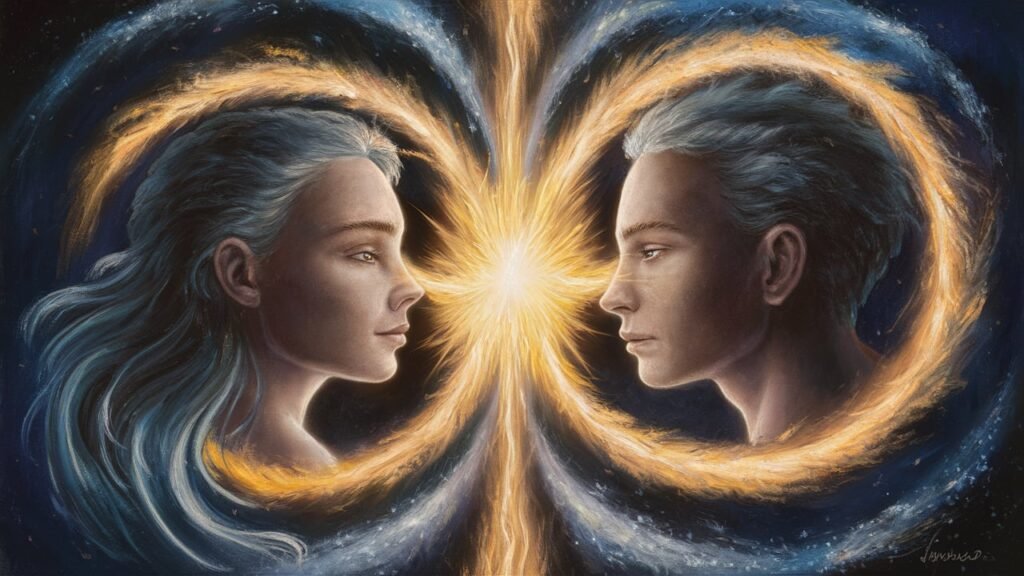
Twin Flames
The twin flame relationship is one of the most powerful soulmate connections, characterized by its complexity and intensity. A twin flame is considered a mirror of oneself in another person, embodying both masculine and feminine energies. This relationship challenges individuals to unconditionally love and accept themselves. Twin flames often go through periods of separation due to the overwhelming intensity of their connection. Only at the highest spiritual evolvement can one reunite with their twin flame, as this bond often defies social norms and stirs deep emotional responses.
Cognitive Development and Attachment
The theory of control systems, also known as cybernetics, played a significant role in shaping Bowlby’s thoughts on attachment. During the 1930s and 1940s, the need for proximity to an attachment figure in young children was understood as a balance between homeostatic needs for safety and exploration. This theory posits that a child’s distance from their caregiver fluctuates based on their needs at the time. For instance, the approach of a stranger or an injury would prompt a child who was exploring to seek closer proximity to their caregiver.
Triad Test and Thinking Styles
The way humans categorize inanimate objects reveals diverse thinking styles. For example, the “triad test” asks individuals to choose two related items from a list such as “train, bus, track.” People from Western cultures might select “bus” and “train” because they are both vehicles, demonstrating a categorical thinking style. In contrast, holistic thinkers might choose “train” and “track” due to the functional relationship between them—one is necessary for the other’s operation.
Karmic Soul Mates
Karmic soul mates are individuals who enter our lives to teach fundamental life lessons such as compassion, empathy, and unconditional love. These relationships are often intense and painful, serving as catalysts for spiritual awakening and personal growth. These connections help individuals confront and clear past-life traumas and issues, making them essential for spiritual development.
Common Hobbies and Mutual Core Values
Having shared hobbies and aligning future goals are vital for a harmonious relationship. When partners prioritize similar values and life objectives, it fosters a deep connection and mutual respect, laying a solid foundation for a thriving relationship. Shared beliefs and mutual growth play crucial roles in soulmate connections, where each partner supports and encourages the other’s personal development and aspirations.
